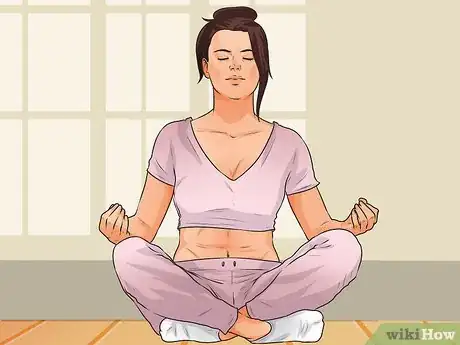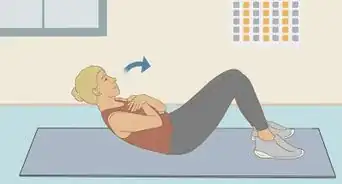X
This article was co-authored by Michele Dolan. Michele Dolan is a BCRPA certified Personal Trainer in British Columbia. She has been a personal trainer and fitness instructor since 2002.
There are 12 references cited in this article, which can be found at the bottom of the page.
This article has been viewed 59,957 times.
Exercise is one of the most important habits to keep as you age. Exercise keeps you healthy, mobile, and mentally aware. However, certain exercises and exercise habits can age you instead of helping you stay healthy and fit. Make sure that your exercise routine avoids mistakes that might age you prematurely.
Things You Should Know
- High-intensity workouts and heavy weightlifting sessions are more likely to lead to injury if you’re on the older side and your body isn’t strong enough to handle tough workouts.
- High-impact workouts can lead to joint damage over time if you’re older, although your body can typically handle high-impact workout programs (like CrossFit) if you’re healthy and on the younger side.
- Low-impact exercises such as biking, light weightlifting, stretching, and resistance band training are great options if you want to keep your body healthy and ward off the effects of ageing.
- Exercise is key if you want to stay healthy as you get older and you’re more likely to feel the effects of ageing if you’re sedentary and don’t work out at least 3 times a week.
Steps
Method 1
Method 1 of 3:
Avoiding Exercise Mistakes That Will Age You
-
1Limit your high-intensity workouts. High-intensity interval training (HIIT) is a great workout. However, if you only do high-intensity workouts and do them too often, you can injure yourself.[1]
- HIIT workouts put more wear on your body and may cause your body to wear down faster without proper rest in between.
- Rest around two days between your HIIT routines to allow your body time to recover.
-
2Refrain from only doing cardio. Cardio exercise is beneficial in a lot of ways, like heart health and lowering blood pressure. However, if that’s all you do, it may age you. Cardio exercise doesn’t do anything to help build muscle mass, which is important as you age.[2]
- As you age, you lose muscle mass. This is a problem because it can lead to a higher risk of falls. Losing muscle mass also slows your metabolism and weakens the skeleton. This means you should include muscle strength training into your workouts.
- You should include two and a half hours of moderate aerobic, cardio activity every week along with at least three days of strength training.[3]
Advertisement -
3Focus on low-impact workouts. Doing low-impact exercises such as walking is safer than doing high-impact workouts as you get older. High-impact workouts such as running may even increase your risk of needing a hip replacement or developing osteoarthritis, especially if you have a high BMI.[4] This is because high-impact exercises cause more pounding and wear on the hip, knee joints, vertebrae, and intervertebral discs. Doin this to your body over and over causes the problem.
- To stay healthy and avoid potential complications from high-impact exercise, limit exercises such as running, jogging, or jumping rope.
- Another option is to mix it up. For example, you can do two days of a low-impact workout, such as cycling, followed by two days of brisk walking workouts, and then finish your week with a high-impact workout, such as jogging.[5]
-
4Use caution when performing shoulder exercises. If you are recovering from a shoulder injury or if you are prone to shoulder problems, then you may want to modify your shoulder strength training. Keeping your shoulder muscles strong is important, but some exercises can put strain on your joints and back.[6]
- For example, you can use elastic resistance bands instead of a machine to do latissimus dorsi pulldowns. Or, you can use dumbbells to do shoulder presses.
- Always follow your doctor's instructions for exercises and other movement guidelines following a shoulder injury or surgery.
-
5Avoid movements that are more likely to cause an injury. Certain exercises are more likely to lead to a bone fracture, especially in those who have weak bones. If you have osteoporosis, then you should avoid these exercises. However, you may also want to avoid them if you are concerned about injuring yourself. These exercises include:[7]
- abdominal exercises with lots of spine flexion, such as sit-ups.
- twisting motions, such as swinging a golf club.
- bending motions, such as a dead lift.
- explosive or high impact movements, such as jumping up onto platforms.
Advertisement
Method 2
Method 2 of 3:
Incorporating Exercises That Are Beneficial To Aging
-
1Strength train. Your body loses muscle mass as you age. Including strength training in your workout routine helps you avoid this. You also help prevent your body from sagging by keeping it firm with muscle tone.[8]
- You should strength train three to four times a week, skipping days in between for muscle recovery. Even just 15 to 20 minutes a day can give you increased health benefits.
- Make sure to include free weights into your strength training workout. Don’t just use machines because that doesn’t work as many muscles as you do when using free weights. Alternating, or using just free weights when you are more advanced, can help build more muscle.[9]
- You may also want to avoid machines that force your arms or legs to move in a fixed path because these machines are more likely to cause an injury.
-
2Do exercises for your posture. As you age, your posture can suffer. Bone health is extremely important to maintain as you get older, and your spine is no different. By incorporating exercises that help your posture, you can help work against osteoporosis or a slouch.[10]
- Try a single leg extension. Get on your back and bend your knees. Place your hands behind your head. As you exhale, pull your belly button towards your spine as you pull your knee to your chest and extend your other leg until it is at about a 45-degree angle. Make sure your lower back remains touching the floor. Do five to 10 reps with each leg.
- Perform these exercises two to three days a week. You can do them more often if you desire.
- However, keep in mind that all types of sit-ups place pressure on your back, so you may want to skip the exercise if you have back problems. Sit-ups are also not recommended for older adults.[11]
-
3Practice yoga. Yoga may help with the aging process. Not only does yoga help reduce stress, but it boosts oxygen, which may make your skin look healthier and younger.[12]
- You can learn how to do yoga at home through books or videos. You can also take yoga classes at your gym, or you can join a yoga studio. Try adding two to three yoga sessions to your workout routine each week.
- Make sure that you listen to your common sense when you take a yoga class. For example, if the instructor suggests a head stand, and you do not feel ready to do one, then don’t. Ask what alternative exercises you can try for your skill level. Remember that building flexibility takes time, so try to be patient and practice yoga in a way that feels safe to you.
-
4Include flexibility and balance exercises. Keeping your body flexible helps you stay fit and mobile as you age. Working on flexibility helps your body and muscles move with more ease. Balance exercises can also keep you agile and mobile while helping you prevent falls.
- You should schedule 20 minutes two or three times each week for flexibility and balance. You can do a routine like yoga or pilates, or you can work on specific flexibility and balance exercises.[13]
Advertisement
Method 3
Method 3 of 3:
Adopting Good Exercise Habits As You Age
-
1Lift appropriate weights. When you strength train, use weights that are heavy enough to create some resistance, but not so heavy that you can barely lift them.
- Choose a weight that you can safely control and lift.
- You should try to do six to eight reps with the weight because this will cause less wear and tear on your joints. The last few reps should be a bit difficult, but not impossible or unsafe.
-
2Schedule in proper recovery time. After workouts, make sure you give your body and muscles plenty of time to recover. As you get older, it takes longer for muscles to recover after a workout.[14]
- If you are still sore, tired, and feel achy, you should rest another day before working out again.
- Remember to leave at least one day per week for rest.
-
3Make sure you always warm-up. Everyone is strapped for time. Maybe you only have 20 minutes to work out or you make it to class late. However, that is not a reason to skip your warm up. Skipping a warm up may cause your body harm. You should warm up and cool down before and after every workout.[15]
- Failure to warm up can lead to injury to cold or unprepared muscles.
- Skipping the warm up might also cause your body’s recovery process to slow down.
- You should do five to 10 minutes of light cardio or lifting to warm up before each workout.
Advertisement
References
- ↑ http://www.prevention.com/fitness/fitness-tips/10-exercise-habits-that-age-you/mistake-you-focus-only-high-intensity
- ↑ http://www.prevention.com/fitness/fitness-tips/10-exercise-habits-that-age-you/mistake-you-only-do-cardio
- ↑ http://www.hsph.harvard.edu/nutritionsource/2013/11/20/physical-activity-guidelines-how-much-exercise-do-you-need/
- ↑ http://www.ncbi.nlm.nih.gov/pmc/articles/PMC3756679/
- ↑ http://www.hsph.harvard.edu/nutritionsource/2013/11/20/physical-activity-guidelines-how-much-exercise-do-you-need/
- ↑ http://orthoinfo.aaos.org/PDFs/Rehab_Shoulder_5.pdf
- ↑ https://www.iofbonehealth.org/exercise-recommendations#Exercises%20not%20suitable%20for%20people%20with%20osteoporosis
- ↑ http://www.foxnews.com/health/2012/05/10/8-diet-and-exercise-mistakes-that-age.html
- ↑ http://www.prevention.com/fitness/fitness-tips/10-exercise-habits-that-age-you/mistake-you-only-use-machines
- ↑ http://www.webmd.com/fitness-exercise/better-posture-exercises
- ↑ http://www.backfitpro.com/pdf/selecting_back_exercises.pdf
- ↑ http://www.foxnews.com/health/2012/05/10/8-diet-and-exercise-mistakes-that-age.html
- ↑ http://www.hsph.harvard.edu/nutritionsource/2013/11/20/physical-activity-guidelines-how-much-exercise-do-you-need/
- ↑ http://www.prevention.com/fitness/fitness-tips/10-exercise-habits-that-age-you/mistake-you-never-take-break
- ↑ http://www.active.com/triathlon/articles/the-real-reason-you-should-warm-up
About This Article
Advertisement





































































